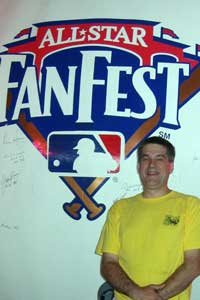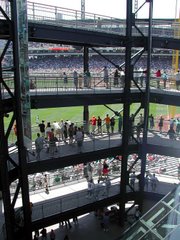Red Sox fans will fondly remember Jim Lonborg as the pitcher who won the Cy Young Award during the Impossible Dream season of '67, pitching his team to the pennant, then throwing a one-hitter and three-hitter in consecutive World Series starts.
Unfortunately for Lonborg, his arm couldn't withstand one day of rest when he got the call to start the Series' seventh game. And his arm really couldn't withstand the shattering it took when he was involved in a skiing accident in the off-season.
By 1973, he was pitching for a bad Phillies team that was just about to turn the corner, and he put in quite a few solid seasons as the right-handed complement to Steve "Lefty" Carlton in the Philadelphia rotation. In the process, Lonborg became a fan favorite, his friendly demeanor serving as a counterpoint to his future-Hall-of-Fame staffmate.
The Phillies won three consecutive NL East titles from 1976-78, but by the last of the seasons Lonborg wasn't pitching effectively, compiling an 8-10 record and watching his earned run average balloon to 5.23.
His status definitely was in question going into the '79 season. He was about to turn 37, and the Phillies had acquired Nino Espinosa (RIP) from the Mets to fill out the rotation. Lonborg made the team, but appeared in just a few games of mop-up relief by the end of May.
When manager Danny Ozark (who would be fired before season's end) finally gave Lonborg a start on June 3, it was at Cincinnati, where the Big Red Machine was on its way to its final division title. As a Jim Lonborg fan, I tuned in to watch the game, even though I had a bad feeling about it. Sure enough, it looked like he was tossing batting practice. The Reds scored three runs in the second and three more in the third, including back-to-back home runs by George Foster and Dan Driessen. When John Bench singled, Ozark came out to the mound to get the ball, and Lonborg walked off mopping up tears with his glove. It was a sad end to a decent career (although I've since learned that Jim made one more relief appearance, giving up three runs in three innings, before the Phils said goodbye for good).
Speaking of sad endings, I remember listening to a Saturday afternoon broadcast of a game between Minnesota and Toronto early in the 1988 season. With the Twins already getting smoked by the Blue Jays, they brought in Carlton, now age 43, to pitch. The Jays had a decent lineup then, and Lefty was no match for the likes of George Bell (home run), Fred McGriff (double) and Lloyd Moseby (another double). Hearing them tee off on the formerly great pitcher was a painful experience.
Like Lonborg, Carlton got one more chance to start a game, but was pounded into submission by a mediocre Indians lineup. The last batter Lefty ever faced was Indians catcher Andy Allanson, who smacked a run-scoring double. The date was April 23, 1988.
Here are some more last stands by some of the great pitchers of the '70s/'80s:
• Nolan Ryan, Texas, Sept. 22, 1993. His last pitch was hit out of the park for a grand slam, no less, by Seattle's Dann Howitt. Who? The first baseman-outfielder hit a total of five home runs in parts of six major-league seasons, but he'll always be able to get mileage out of being the answer to a trivia question.
• Tom Seaver, Boston, Sept. 19, 1986. I remember Tom Terrific sitting on the bench during the Sox' postseason run, but he was injured and never appeared in a game again. In his final appearance, he started against and lost to Toronto, trailing 3-2 when Sammy Stewart relieved him and coughed up three more runs. Tony Fernandez, who flied out, was the last batter Seaver faced.
• Phil Niekro, Atlanta, Sept. 27, 1987. Baseball fans thought he might pitch forever, but the knuckleballer finally ran out of steam at age 48. After his release by Toronto, the Braves - the team that, when it still was in Milwaukee, first signed him back in 1958 - brought him back for one more start. He gave up six hits, five runs and walked six Giants before manager Chuck Tanner removed him in the fourth inning. Niekro's last pitch walked Kevin Mitchell with the bases loaded.
• Ferguson Jenkins, Chicago Cubs, Sept. 26, 1983. Jenkins' final appearance was an inning of relief against the Phillies, the team that originally signed him, then included him in an ill-advised trade with the Cubs. Jenkins immediately went on to win 20 or more games six straight season. He bounced around a bit before returning to Chicago for two final, forgettable seasons. In his finale, Jenkins gave up a single to Mike Schmidt and home run to Joe Lefebvre before retiring Garry Matthews and Greg Gross as the final two batters he faced.
• Tommy John, New York Yankees, May 25, 1989. John's career spanned seven presidencies, JFK through Bush I, and he actually pitched longer in the majors after having the surgery that is named after him. He made the Yankees, a lousy team at the time, coming out of spring training in '89, but his aged arm had lost all its zip. Although he had a 2-7 record, manager Dallas Green trotted John out one more time in a game against the Angels. Although New York won the game, Tommy didn't earn the victory, as his lead was blown by Dale Mohorcic. John's last pitch was hit for a single by Devon White.
Subscribe to:
Post Comments (Atom)









No comments:
Post a Comment